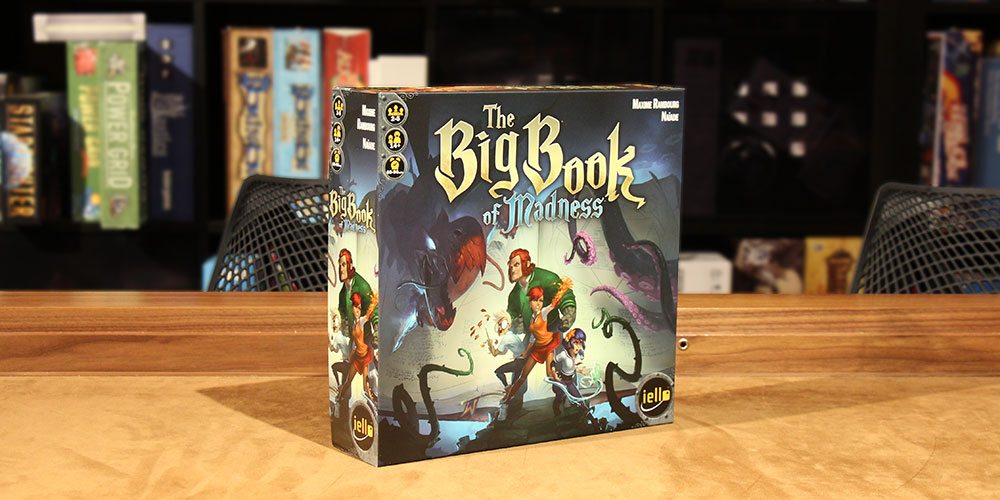
As aspiring magicians at Elementary College, you’ve become frustrated with your progress. But all is not lost! You and your fellow students know of a book in the basement that holds magical secrets, so on a dark night, you head down the stairs to see what can be learned from this grimoire. As the cover is lifted, the book comes to life, releasing horrible creatures who’ve been imprisoned in the book, now looking to wreak terror and havoc on the world. Quickly, you and your classmates must learn and cast spells and drive the monsters back to the book… before you’re driven mad. The Big Book of Madness is a cooperative deck-building game for two to five players, aged 14 and up, and plays in about an hour.
Components
Iello makes great games, and not only does The Big Book of Madness look incredibly gorgeous and spooky (at the same time)—the artwork is absolutely wonderful—the quality of the components is all top-notch. Inside the box, you’ll find:
- 48 Curse cards (full-size cards)
- 35 Madness cards (mini cards)
- 136 Element cards, 34 of each of the four Elements, water, earth, fire, and air (18 value-1, 10 value-2, 6 value-3) (mini cards)
- 20 Basic spell cards (four types, one for each player)
- 36 Library spells, 9 for each Element ( 3 of each value-1, value-2, and value-3)
- 8 Magician sheets with player aid on the backs
- 17 Grimoire cards
- 1 Invocation marker
- 1 Round marker
- 1 Active player token
- 16 Element tokens (4 for each Element)
- 1 Gameboard

The Magician cards are all different; each one has his or her own special power and a different distribution of Element cards for their starting hands. The Grimoire cards are cleverly designed in that there are multiple front cover cards, a dozen interior pages, and a single back to the book. This way, the book can be set up differently many times before repeating a game. The markers are especially neat—the Invocation marker is a plastic, two-toned book and the Round marker is a witch’s hat. All of the cardboard and cards are done really well, and all of it fits in a really outstanding box insert. Everything has a place and it’s intuitive where the bits go. An insert like this makes you appreciate the thought that went into the complete design and leaves you wishing more attention was generally paid to inserts.
How to Play
Setup is fairly straightforward. Everyone picks a Magician card and is dealt Element cards according to what is on their Magician card; these serve as the starting decks. Everyone gets the same four basic spells to begin the game. It’s important for players to discuss which Magician they want to play because different Magicians specialize in different Elements and you’re going to need all four Elements to survive the evening.
Value 2 and 3 Element cards are placed in front of the board, along with randomly chosen value 1, 2, and 3 spells from each Element. Curses are also stacked by the board, after shuffling and sorting by Element. The Element Tokens are placed nearby–it’s not a guarantee that you’ll use them in your game since they are only distributed as certain Curses are drawn, but it’s nice to have them nearby.
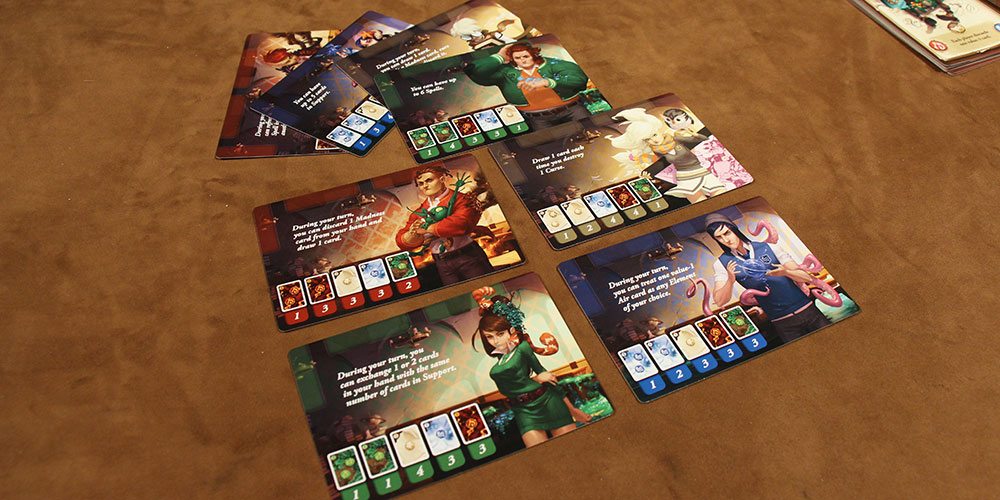
The Madness cards are counted and placed on the board, consulting a table in the rulebook, the number of cards is adjusted according to the number of players in the game. The Grimoire is also assembled with random pages and placed on the board.
Finally, the Invocation marker is placed at the start of the Invocation track and the round marker is placed on the round track, according to the difficulty you want to play. There are three difficulties, easier, medium, and harder. Play is now ready to begin.
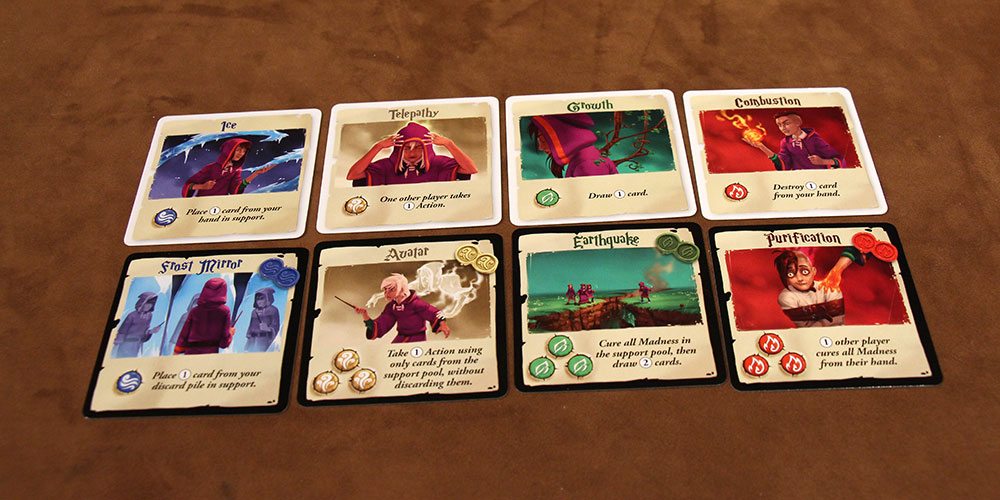
To win, you must defeat the last monster in the Grimoire. You don’t have to beat the others, but if you don’t, the odds will be stacked against you and horrible things may happen to you along the way. Failure to destroy a Curse before arriving at its space on the Invocation track means bad things will be happening to players. A lot but not all of the bad things involve taking Madness cards into your hand. Like other deck-builders, the more Madness (trash) cards you have in your hand, the fewer actions you can take.

As play begins, the Grimoire is opened and an immediate effect is applied. After that’s resolved, the monster gives the players three Curses, along with whatever the Curses dictated by the round track. Curses are placed along the Invocation track with a single Curse placed at the second spot, two cards for the third spot, and a single card at both four and five. Players may face as many as five Curses on any (or all) rounds. On the easiest difficulty, you may face just three Curses. A nice benefit on the Grimoire cards is that the right facing page, which tells the benefit or penalty that players will face for destroying or allowing a monster to live is found in the bottom right. Here there are icons for the Curses that the next Monster will be throwing at you. Thanks to this hint, players can prepare for the subsequent round while battling Curses in the current round.
Players take turns completing four phases. The first thing a player does is refresh their spells if any of them have been tapped by being used in the previous round. The monster Curses activate first on a player’s turn. The player activates the Invocation marker, moving it forward a single space and reading the Curse’s effect (if there’s a Curse on that space of the Invocation tracker). Curse cards have two basic pieces of information: four symbols showing what Elements are required to vanquish the Curse and some text that show’s the effect of the Curse.
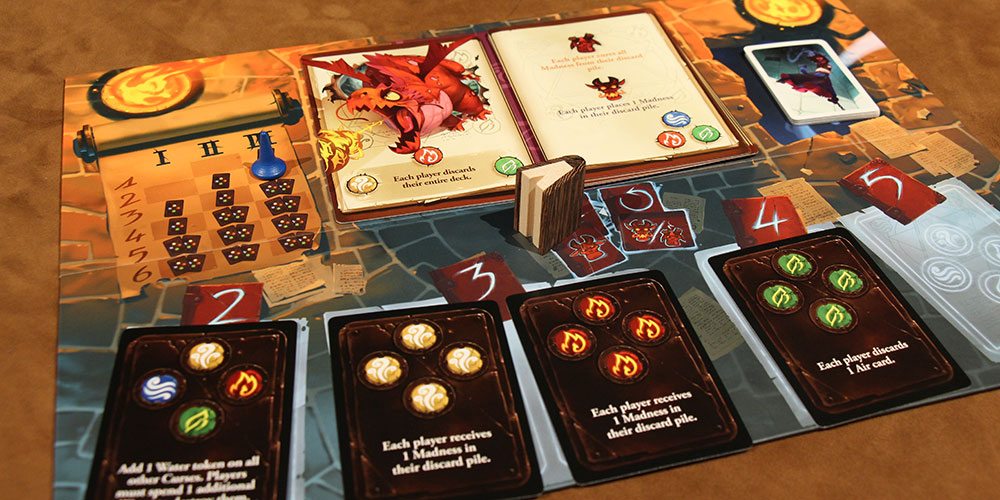
The player then gets a chance to respond, through five different actions. A player may take as many of these as she wishes, as long as she has Element cards, which are, essentially, the game’s currency, to pay for the action. She can:
- Activate a spell. Even though spells can only be activated once per turn, a player can pay two or three times the spell cost to have it affect its target two or three times. Basic spells include the ability to draw an extra card, destroy a card from the player’s hand, allow a player, who is not the active player, to take an action, or to put a card into support. A player can put up to three cards into support and these cards are, essentially, community cards. Anyone can use them, but after use, they go to the discard pile of the player who put them into support. Spells that have been activated get tapped.
- Learn a new spell. By paying a spell’s cost, a player can learn a new spell, which is placed in front of that player. A player may never have more than five spells (discard old ones as needed) unless she has a power saying that she can have more.
- Acquire an Element card. By discarding two matching value one cards of an Element, players can acquire a value 2 card of that same Element. A value 2 and a 1 will get you a value 3. All of the cards then go to your discard pile.
- Destroy a Curse. By discarding value 4 Element cards that match the four symbols on the Curse cards, that Curse can be removed from the Invocation track. You can overpay in the number of symbols on your Element cards, but you don’t receive any balance in return.
- Cure Some Madness. By discarding two Elements of the same type, you can cure one Madness card and return it to the supply. It’s important to cure Madness rather than destroy it because if the supply ever reaches zero, you lose.
Players then draw up to (or down to) six Element cards in their hand. If, at any time, your hand consists of six Madness card, you have gone insane and are eliminated from the game.

Play continues with players moving along the Invocation track until a complete loop has been made. If all Curses have been vanquished, the players get a benefit. If Curses still sit on the track, players get hit with a penalty, the track is wiped clean, the Grimoire gets turned to a new page, and the process starts over. If you beat the final monster by vanquishing all its Curses, you win. If there are any Curses left, you lose. You also lose if the Madness stack is ever depleted or all players are eliminated.
Why You Should Play
We enjoyed The Big Book of Madness for a few reasons. It’s a more challenging game than a lot of current Iello offerings. There are lots of things to consider when taking a turn and the possibilities encourage discussion, making it a truly cooperative game. As a team, you have to plan ahead several turns to make sure you have enough Element resources to destroy the upcoming Curses. This strategic thinking is a good part of the reason that the suggested age is 14, I think. My fourteen-year-olds struggled a bit with the game the first time, although their brains were sort of mushy from studying for finals at the time. Cooperative games like The Big Book of Madness can suffer from a single player taking charge and dictating the game, but because the round has a rotating active player, this discourages one player from quarterbacking the game.
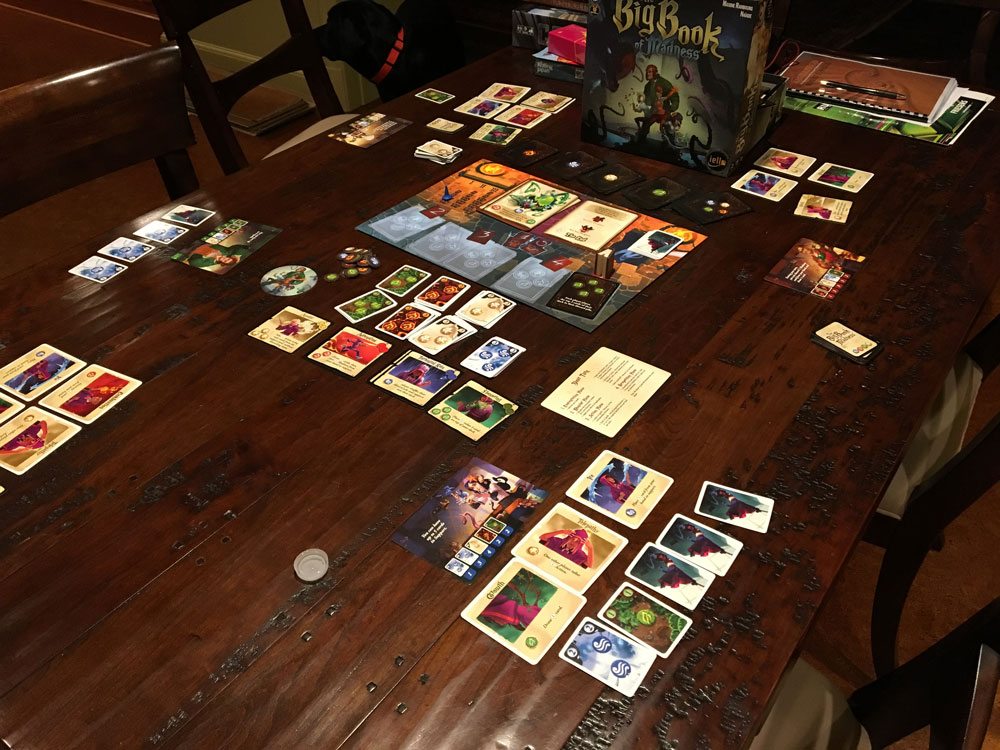
There is a good bit of luck in the game—both in the monsters that are presented and the Curses that they present. You have more control of the cards that end up in your deck, but there’s still some uncertainty about which ones you’ll deal into your hand and, for these reasons, The Big Book of Madness can be absolutely brutal, as you draw wrong cards and have to watch your impending doom approach with a slow cruelty. It can also make the game pretty easy or some difficulty in between. However, if you are a sadist or up for a challenge, there are several ways to make the game tougher. By choosing the hard path on the Round track, you’ll face more Curses and players can also start with Madness cards in their deck or replace higher value cards with lower value cards, simply because they loathe their sanity.
The game scales pretty well, playing just about the same with two as it does five, which is nice because, with more players, there is a bit of sitting around. Depending on the players in the game, there may be more or less discussion, depending on your group. Less discussion can mean the phones come out and minds wandering a bit.
Iello has ventured into Lovecraftian-type universes a few times before in Night of the Grand Octopus, Shadows over Normandie, and the upcoming Rob Daviau title, Mountains of Madness, and The Big Book of Madness wears the theme well. It’s Lovecraft-light, but madness’s tentacles still seem too real. The game feels very beatable at first, but as you add Madness cards to your deck, it becomes a struggle and one whose outcome can end up being decided on the final turn, as happened to us a couple of times. That makes for a really enjoyable time and is why you should check out The Big Book of Madness.
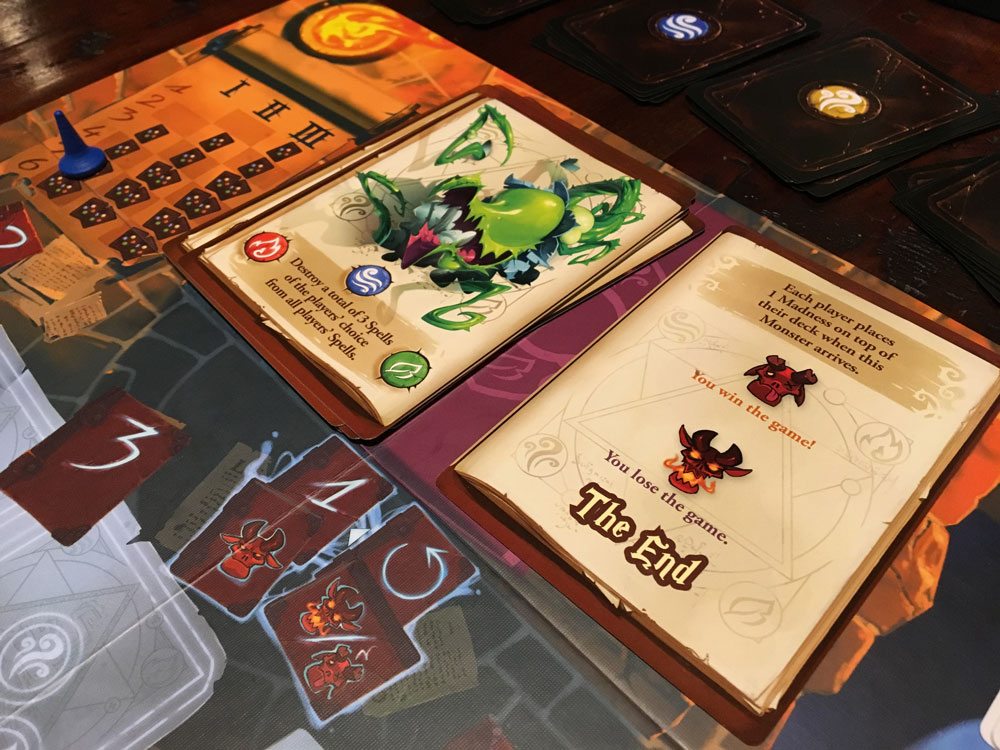
Disclosure: GeekDad was sent a copy of this game for review purposes.


